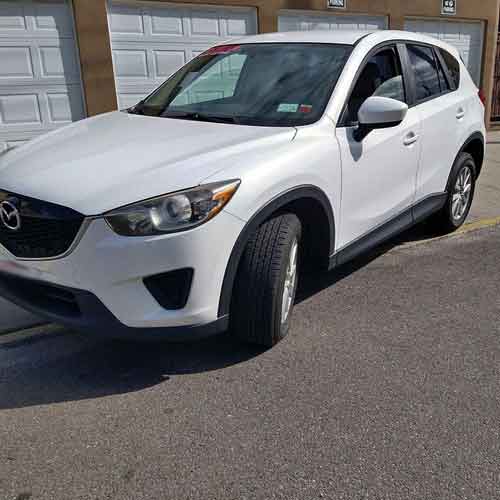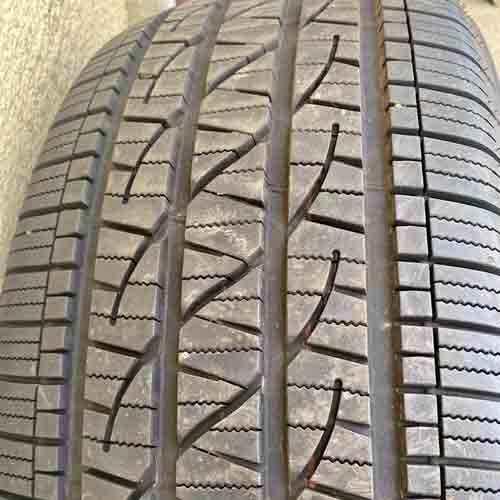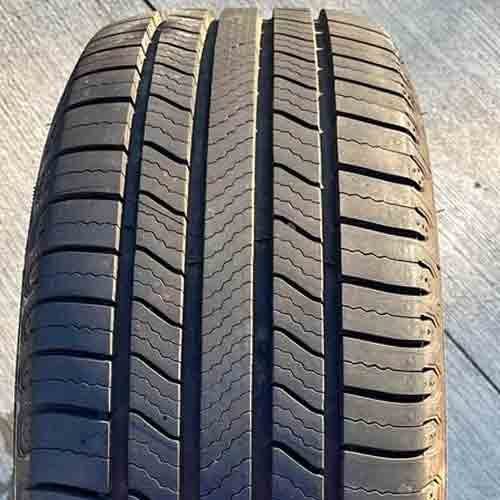The Firestone Destination LE3 is a highway all season tire, while the Michelin Defender 2 comes in standard touring category. Let’s see what are the main differences, comparing these boys.

Being a tire engineer, I can tell you that the Michelin Defender 2 stands out with its enhanced directional grip, superior dry handling/precise steering, increased fuel efficiency through a lighter build and reduced rolling resistance, and extended tread life, all while offering a quieter ride. Conversely, the Firestone Destination LE3 leads in winter conditions, (particularly on snow), and it offers superior wet performance. And although its slightly noisier than the Michelin, it offers decent impact comfort.
Table of Contents
Sizes Facts
The Michelin Defender 2 comes in 16 to 20″ inches rims, having following specs.
- Speed ratings: H (on all)
- Load ratings: SL and XL
- Tread depth range: 10.5/32″ (on all)
- Weight range: 25 to 32 lbs
- Winter ratings: Only M+S no 3PMSFR.
- Tread mileage rating: 85k miles.
- UTQG rating: 800 A A.
Review this tire in greater details: https://tiredriver.com/michelin-defender-2-review/
The Firestone Destination LE3 comes in 15 to 22 inches wheels. And all of those sizes have following specifications.
- Speed ratings: T, H and V.
- Load ratings: SL and XL.
- Tread depth range: Almost all sizes have 10/32″.
- Weight range: 21 to 40 lbs.
- UTQG: 700 A B
- Winter ratings: No 3PMSF, only M+S.
- Tread mileage rating: 70k miles warranty.
Review this tire in greater details: https://tiredriver.com/firestone-destination-le3-review/
Construction Comparison
The Firestone Destination LE3 comes with a distinctive symmetric tread pattern.

The tire comes with 3 ribs in the middle, which are distinguished with F and S shaped lugs (S on the central most, while F on adjacent ribs).
These shapes are basically from the curved lateral grooves on all ribs.
They join together with 4 circumferential channels, allowing for decent resistance to hydroplaning.
And since they also act as in-groove biters, they combined with lateral notches, and chamfered edges (also seen on these lugs), provide great traction.
Though shoulder lugs are less aggressive. I mean they although carry similar siping pattern, they aren’t any milt-angled groove there.
But you do have longitudinal slits, followed by lateral notches.
Internally, the tire comes with a single ply polyester casing with 2 steel belts and a nylon reinforced cap ply on the very top.
The Michelin Defender 2 on the other side, also features a symmetric pattern. But of course, one can see it’s way less aggressive in comparison.

I mean, contrasting its shoulder lugs, (with those of its competitor), it’s pretty evident how simplified they are.
These lugs primarily feature lateral grooves, and basic interlocking siping.
The central 3 ribs, on the other hand, are also not as aggressive, they are still carrying sightly more features, compared to shoulders.
Here, the middle most rib is continuous-running, and comes with a lot of siping.
While the adjacent ribs carrying similar siping structure, also have wave-like groove as well.
And with the help of these grooves, outer circumferential channels are connected with each other, allowing for water dispersion.
Inside, the tire is built with a single layer of polyester casing, reinforced with two steel belts and a nylon cap ply.
Pavement Performance
The efficacy of pavement performance (under dry conditions), is critically determined by several key aspects, which include the tire’s capacity for acceleration, its braking efficiency, and cornering.
Let’s get into them all.
Directional Grip
Now the directional grip involves two primary considerations, one is that its effectively measured by tire’s braking abilities, and two, it’s heavily reliant on the design of the central tread region.
The significance of the central tread area cannot be overstated, as it bears the most of the vehicle’s weight (I mean, during straight-line maneuvers).
And so given this it makes sense why the Defender 2 comes on top here.
The tire features continuous-running and more streamlined central ribs, which make a consistent/better contact with the road.
Moreover, it’s lighter weight is also helping here a lot (thanks to it’s lighter single ply polyester casing). Basically it allows it to keep its momentum low (when moving at high speeds), meaning it’s easier to stop.
On the other side, the Destination LE3 faces a couple of notable challenges:
Firstly, it’s presence of multiple notches and substantial siping within the tire’s design, notably reduces the amount of rubber available to make contact with the road, reducing overall contact patch and with it, grip.
Secondly, the tire’s bulkier structure contributes to increased momentum inertia, rendering it more difficult to stop.
So it makes sense why Firestone’s tire stops, showcasing an average braking distance which is 6 feet shorter in comparison to Michelin’s.
Dry Handling and Steering
The art of cornering on dry pavement can be broken down into three critical stages, each with its unique demands on tire performance.
- Entry Phase: This initial stage requires tires to execute precise braking.
- Mid-Cornering: At this point, the necessity for exact steering feedback becomes paramount.
- Exit Phase: This is post cornering phase, where tire are straightened, so they must support the reintroduction of acceleration smoothly and effectively.
Now, the Michelin Defender 2 demonstrates superior performance in all these key areas. It offers superior braking (as you must have already seen in the previous section).
Moreover, it’s stiffer rubber composition, and a lightweight design significantly contributes to sharper mid-corner feedback, which is very essential, (as it tells you, as a driver, how much lateral grip is left).
Speaking of which, the tire also features superior lateral grip, with it’s minimalist shoulders. (With less tread features, it’s shoulder make better contact with the road).
Moving towards the Firestone Destination LE3, this tire falls short, to nobody’s surprise, since it comes in a highway all season category (with more aggressive tread).
Though since it’s one of the best here among it’s group members, it only lacks to Defender 2 by a mere second, on average in handling time tests.
Tread Longevity
The lifespan of a tire’s tread depends on a blend of various design elements, including its compound, tread pattern, depth, and the overall structural weight.
And here the Michelin Defender 2 is leading the way. In fact, it’s the longest lasting tire, when it comes to touring all season category.
So what makes this tire so great?
Well, for one, it’s construction incorporates a lighter structure, which when coupled with MaxTouch Construction technology, distributes the forces of acceleration, braking, and cornering evenly, mitigating excessive wear.
Moreover, it also comes with a EverTread compound, which is formulated with specialized polymers that are innately resistant to heat, a common detriment to tread life.
On the flip side, the Firestone Destination LE3 although is pretty great for its category (of highway all season tires), still lacks here of course, with a heavier built and a more aggressive tread pattern.
Noise Dampening Ability
Essentially, road noise is generated when air impacts the tire’s tread walls, particularly entering through the spaces between the shoulder lugs (for the most part).
So overall acoustic performance highly depends on the tire’s design.
That’s why out of both tires, the Michelin Defender 2 is a quieter option, which manages road noise well. And with ridges/blockers, between the shoulder lugs, there’s less noise to begin with.
Moreover, the tire also offers a sophisticated combination of rubber compounds in the tread and the utilization of advanced variable pitch technology.
It’s rubber basically does not echo the noise, reducing in-groove resonance, while it’s variable pitch design alters the points of contact for the airflow.
And this creates a range of sound frequencies that are less likely to resonate together.
Moving towards the other tire, the Firestone Destination LE3 falls short with it’s more voided up design, allowing more air to play around. And yes, with a lot more biters, the tire also adds in a lot of growling noise too.
Winter Traction
When considering the effectiveness of tires under winter conditions, one must analyze several key factors. These include the tire’s grip on “icy” surfaces, handling stability, and its adaptability to snowy terrains as well.
Now of course, both these tires lacking the 3 Peak Mountain Snowflake certification aren’t going to impress anyone, yet it’s noteworthy that the Firestone Destination LE3 manages to surpass those (lower) expectations.
Now this is all thanks to it’s thoughtfully engineered design, which offers extensive wave-like siping, multi-angular biters (in the form of “F” and “S”), and powerful chamfered edges.
All these features are instrumental when it comes to biting on both icy and snowy terrains.
In contrast, the Michelin Defender 2 does not measure up, especially in terms of lateral grip and steering response. And the main culprit here is the tire’s relatively stiffer rubber, which further gets more rigid as the temperature drop, compromising flexibility and traction.
And yes, of course, unlike the Firestone, it also misses out on ample biting edges, which enhance the tire’s ability to lock into the snowy surface.
Wet Performance
Achieving a good traction on wet surfaces is a complex task, as it really is dependent on how well the tire is able to clear water from the road in front of it (as it rolls).
And here, sipes and grooves come in to action.
Grooves offer clear channels for water to pass through, while sipes, well they suck up the remaining moisture (left out by grooves), as they expand/contract.
So a good tire here should have ample sipes/grooves, and a flexible rubber.
And that’s where the Michelin Defender 2 encounters some limitations. I mean sure, its sophisticated array of full-depth sipes, try to enhance its wet grip, but it’s stiffer rubber comes in the way.
So those sipes aren’t able to work at their full capacity.
In contrast, the Firestone Destination LE3 is designed with interconnected grooves that initially displace a greater volume of water.
This innovative design (which they call hydro-grip technology), reduces the reliance on sipes, as they have less water to clear off, to begin with.
And yes, since the tire also benefits from a comparatively softer rubber compound, the sipes are able to create a more effective suction effect that draws water away from the tread surface, allowing for direct contact with the road.
So overall, Firestone is better, showcasing superior hydroplaning resistance (with its effective grooves), and better wet traction too, (thanks to it’s more efficient siping design).
Fuel Economy
The quest for fuel-efficient tires comes with a challenge that revolves around reducing rolling resistance.
This resistance is technically a frictional force resisting the motion of a tire as it rolls across a surface. And here, the factors affecting it are the tire’s weight, it’s internal/external construction, and the chemical composition of its tread.
Now, taking these variables into account, the Michelin Defender 2 stands out clearly, offering considerable improvement in fuel economy, as seen by it’s (comparatively better) average mpg readings.
As a standard touring tire, its relatively lighter build, and less aggressive tread design contributes to a lower rolling resistance.
The less aggressive design is self explanatory, while it’s lighter structure alleviates the stress on the tire lugs, so they stay in shape, (even during harsh maneuvers), and don’t loose energy to heat or restoration of the tread shape.
While the opposite happens on the Firestone’s tire, which is heavier and more aggressive.
Concluding Remarks
When all is said and done, the essence comes to this.
Out of both boys, the Michelin Defender 2 excels in the following:
- Enhanced directional grip, due to its streamlined central ribs, providing better contact with the road.
- Superior dry handling and steering feedback, aiding in more precise cornering.
- Greater fuel efficiency, attributed to its lighter construction.
- Longevity in tread life, thanks to its MaxTouch Construction technology and EverTread compound.
- Quieter ride due to advanced pitch sequencing.
While the Firestone Destination LE3 takes the lead in:
- Winter traction, with design elements like wave-like siping and chamfered edges that grip icy and snowy surfaces more effectively.
- Wet performance, with interconnected grooves and a softer rubber compound that excel in displacing water and preventing hydroplaning.